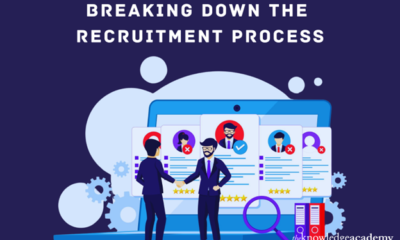Business
Shannon Swanick TPO: Boost Your Business with Expert Guidance!

When it comes to growing your business, having the right guidance can make all the difference. That’s where Shannon Swanick TPO (Third-Party Origination) steps in! Shannon Swanick is not just any expert; she’s a powerhouse in the world of business consulting, especially for companies looking to expand through TPO. If you’re curious about what Shannon Swanick TPO can do for your business, keep reading. You’re about to find out how her expertise can help you make smarter, faster, and more profitable decisions.
Table of Contents
What Is Shannon Swanick TPO?
Shannon Swanick TPO is all about offering businesses tailored solutions for third-party origination. But what exactly is TPO? Simply put, TPO refers to outsourcing certain parts of your business operations to a third party, which can save you both time and resources. Shannon specializes in this area, helping businesses streamline processes, improve efficiency, and achieve their growth goals. Whether you’re a small startup or a well-established company, Shannon’s TPO services are designed to fit your unique needs.
Why Choose Shannon Swanick for TPO?
There are plenty of TPO consultants out there, so why should Shannon Swanick be your go-to choice? Here are some reasons why her clients keep coming back:
- Customized Solutions: Shannon doesn’t believe in a one-size-fits-all approach. She takes the time to understand your business, your goals, and your challenges before crafting a tailored strategy.
- Proven Track Record: With years of experience and a list of satisfied clients, Shannon knows what works and what doesn’t. She brings a wealth of knowledge and insights that can help steer your business in the right direction.
- Cost-Effective Services: Outsourcing can save you money, and Shannon ensures you get the best bang for your buck. By optimizing your TPO strategy, she helps reduce costs without sacrificing quality.
How Shannon Swanick TPO Can Transform Your Business
Wondering what Shannon Swanick TPO can do for you? Here are some key areas where her expertise can make a difference:
1. Streamlined Operations
- Shannon analyzes your current processes to find bottlenecks and inefficiencies. Then, she works with you to implement a smoother workflow, allowing your team to focus on what they do best.
2. Enhanced Customer Experience
- When you outsource with TPO, you can concentrate on customer satisfaction. Shannon helps ensure that the third-party services you use meet your standards, keeping your customers happy and loyal.
3. Scalability
- Are you ready to take your business to the next level? Shannon’s TPO strategies make it easier to scale up without overextending your resources. This means you can grow at your own pace, confidently and sustainably.
4. Risk Management
- With Shannon Swanick TPO, you can better manage risks. She identifies potential issues and helps you plan ahead, reducing the chances of costly mistakes and setbacks.
The Benefits of Working with Shannon Swanick TPO
Working with Shannon isn’t just about outsourcing—it’s about transforming your business. Here are some of the benefits you can expect:
- More Time for Core Activities: By outsourcing specific tasks, you free up time to focus on your main business goals.
- Reduced Overheads: Save on the costs of hiring, training, and maintaining an in-house team. Shannon ensures you’re only paying for what you need.
- Access to Expertise: Shannon’s experience and knowledge in TPO mean you’re getting top-notch advice and support from someone who knows the ins and outs of the industry.
Getting Started with Shannon Swanick TPO
Ready to see what Shannon Swanick TPO can do for you? Here’s how to get started:
- Schedule a Consultation: The first step is a conversation. Shannon will discuss your needs and objectives to determine if TPO is the right fit.
- Analyze Your Business: Next, Shannon will dive deep into your operations, identifying areas for improvement and potential TPO opportunities.
- Develop a Custom TPO Strategy: Based on her findings, Shannon will craft a plan that aligns with your goals. This plan will outline which tasks should be outsourced and how to maximize the benefits.
- Implement and Monitor: Once the strategy is in place, Shannon will work with you to implement the plan and monitor progress, making adjustments as needed to ensure success.
Final Thoughts
Shannon Swanick TPO is a game-changer for businesses looking to streamline operations, save money, and scale effectively. With her personalized approach, proven expertise, and commitment to client satisfaction, Shannon can help you navigate the complexities of third-party origination with ease. So, if you’re ready to take your business to new heights, Shannon Swanick TPO might be the partner you’ve been looking for!
FAQs
1. What is TPO in business?
TPO stands for Third-Party Origination, which involves outsourcing certain business functions to a third party. This approach can help businesses save time and resources while focusing on core activities.
2. Why should I choose Shannon Swanick TPO?
Shannon offers customized solutions, a wealth of experience, and cost-effective strategies that help businesses streamline their operations and grow efficiently.
3. How does Shannon Swanick TPO help with risk management?
Shannon identifies potential risks in your operations and helps you plan ahead to avoid costly mistakes and setbacks, providing peace of mind as you grow your business.
Business
Education Loan Explained: Eligibility and Advantages

Quality higher education can lay the foundation for a successful and fulfilling career. However, the rising cost of education often becomes a challenge for many students and their families. In such a case, opting for an education loan can be a suitable option. An education loan helps students cover their financial requirements without putting pressure on their families. There are many banks and Non-Banking Financial Companies (NBFCs) that provide education loans at competitive rates. This article explains what education loans are, their advantages, eligibility criteria, and more.
Table of Contents
What is an Education Loan?
A loan for education is a type of financial aid offered by banks or financial institutions to help students pay for their higher education. This loan generally covers all the expenses such as tuition fees, accommodation, books, travel (if studying abroad), and other related costs. These loans can be used for studying in India or abroad. Some education loans also offer flexible repayment options and allow students to begin repayment after completing their course.
Eligibility Criteria for an Education Loan
The eligibility for an education loan may vary from lender to lender, but the common requirements include:
1. Nationality
To qualify, an applicant must be an Indian citizen. It’s important to note that loan options, interest rates, and repayment terms can vary across banks and financial institutions, so comparing lenders is essential before applying.
2. Academic Qualification
The student must have secured admission to a recognised institution in India or abroad through an entrance test or merit-based selection. This helps lenders ensure that the loan is given to students pursuing serious and credible courses. The institution should be accredited or approved by the relevant education authorities. Proof of admission is usually required during the loan application process.
3. Age Limit
Generally, the applicant’s age should be between 18 to 35 years at the time of applying for the loan. Some lenders may have slight variations in age criteria depending on the course or loan scheme. This age range is considered suitable as it aligns with most students pursuing higher education. In certain cases, older students may be eligible but may need to fulfil additional requirements.
4. Course and Institution
The loan is usually sanctioned for professional or technical courses like engineering, medical, management, and similar fields from recognised universities. One thing to note is that lenders prefer courses that offer strong career prospects. This makes them sure that the student will be able to repay the loan after completing his/her studies. Some lenders may also provide loans for diploma or vocational courses if they meet certain criteria.
5. Co-applicant
A co-applicant (usually a parent or guardian) is mandatory. The co-applicant’s income and credit history are considered to determine loan approval and amount. Having a reliable co-applicant increases the possibility of getting a higher loan amount and better loan terms. The co-applicant is equally responsible for repaying the loan if the student is unable to do so.
Advantages of Education Loans
Education loans offer several benefits that make them a preferred financing option for students:
1. Financial Independence
Thanks to education loans, students can attend the institution and pursue the course they want, without relying only on the family’s savings or selling valuable assets. This means they can concentrate on learning, since their needs are taken care of. With educational loans, students can choose what they want to study, regardless of how much funds they have now.
2. Affordable Repayment Options
Students can be given more time to pay back the loan, often during the duration of the course and for several months after its completion. Therefore, interest and loan payments are not required right from the beginning. You can pay back the loan in smaller instalments over an extended time.
3. Tax Benefits
Under Section 80E of the Income Tax Act, the interest paid on education loans is tax-deductible for up to 8 years. This can reduce your overall tax burden significantly. However, the benefit applies only to the interest, not the principal loan amount.
4. Covers a Wide Range of Expenses
Apart from tuition, loans may cover costs like accommodation, travel (for foreign studies), exam fees, and other educational materials. This helps students manage all education-related expenses in one place. Some loans also include funds for internships or training programs linked to the course.
5. Improves Credit Score
Timely repayment of education loans, along with managing the education loan interest rates responsibly, helps build a strong credit history. This tends to make it easier to secure other loans in the future.
Conclusion
For students aiming to get a quality higher education, education loans give them the confidence to focus on their studies rather than their budget. If students meet the eligibility criteria and decide on the proper loan, they can easily manage fees for schooling and get improvements in their credit scores, plus enjoy better tax terms and hassle-free repayment. With support from banks and NBFCs, education loans make it easier to focus on learning and building a secure future. If you plan carefully and repay on time, an education loan can support you in building your career.
Business
Comprehensive Guide to Real Estate Valuation in Frankfurt: Market Trends and Insights

Frankfurt, Germany’s financial powerhouse, is a city known for its blend of modern infrastructure, historical charm, and high economic potential. As one of the most influential financial centers in Europe, the demand for real estate valuation in Frankfurt continues to grow, making Immobilienbewertung Frankfurt in this city a crucial element for investors, homeowners, and businesses alike. Understanding the dynamics of the Frankfurt property market, along with the factors influencing property values, is essential for anyone looking to invest or engage in property transactions in the city. In this comprehensive guide, we will delve into the key elements of real estate valuation in Frankfurt, providing insights into market trends, valuation methods, and important considerations for both buyers and sellers.
Table of Contents
The Role of Real Estate Valuation in Frankfurt
Real estate valuation refers to the process of estimating the market value of a property. This assessment is vital for various stakeholders, including property buyers, sellers, investors, lenders, and government authorities. In Frankfurt, real estate valuation in Frankfurt plays a particularly significant role due to the city’s status as Germany’s economic hub and its position as a central player in the European market. Whether you are purchasing a residential property, commercial space, or land for development, understanding the nuances of valuation can help you make informed decisions and mitigate risks.
Key Factors Influencing Real Estate Valuation in Frankfurt
The valuation of real estate in Frankfurt is influenced by several key factors. Economic conditions are among the most significant, as a strong economy typically drives demand for property. Frankfurt, being home to the European Central Bank and numerous multinational corporations, benefits from a robust financial sector, resulting in continuous demand for both commercial and residential properties.
Other factors affecting property values include the location, size, and condition of the property. For example, properties located in central areas like Innenstadt, which offers proximity to financial institutions and cultural landmarks, tend to have higher valuations compared to properties in suburban neighborhoods. Similarly, the age and condition of the building, the availability of amenities, and the overall design and layout are critical considerations when determining value.
Additionally, external factors such as interest rates, government policies, and urban development projects can impact real estate prices in Frankfurt. For instance, the city has been undergoing significant development, including residential and commercial projects aimed at accommodating the growing population and workforce. These developments can influence demand and, in turn, property values.
Market Trends of Real Estate Valuation in Frankfurt
The real estate valuation in Frankfurt has seen several notable trends over the past few years. A growing demand for residential properties, particularly in the luxury and high-end segments, has been driven by an influx of expatriates and professionals working in the financial sector. This trend is reflected in the rising property prices in districts like Westend and Sachsenhausen, where modern apartments and upscale buildings are in high demand.
Another key trend is the increasing demand for sustainable and energy-efficient properties. As environmental concerns continue to rise, buyers and investors are becoming more conscious of energy consumption and sustainability. Consequently, buildings that adhere to green building standards and have energy-efficient features are being valued higher than older, less efficient properties. This shift toward sustainability has also led to greater interest in renovation projects, with many buyers opting to refurbish older properties to meet modern energy standards.
Moreover, the COVID-19 pandemic has had a profound impact on the real estate valuation in Frankfurt, as it has elsewhere. While the demand for office spaces has seen some fluctuations, residential real estate, particularly in suburban areas, has gained traction due to remote working trends. Many professionals now seek more spacious homes outside the city center, leading to increased interest in properties in neighborhoods like Bockenheim and Nordend.
Common Methods of Real Estate Valuation in Frankfurt
There are several methods employed by real estate professionals to determine the value of a property in Frankfurt. Each method considers different factors and is suited to specific types of properties.Sales Comparison Approach: This is one of the most commonly used methods in residential real estate valuation in Frankfurt. It involves comparing the property being valued with similar properties that have recently sold in the same area. The assumption is that the price of a comparable property is a good indicator of the market value of the subject property.
Income Approach: This method is primarily used for commercial properties, such as office buildings or apartment complexes. It estimates the value of the property based on the income it generates, including rental income and other revenue streams.
The income approach is particularly useful for investors looking to assess the potential return on investment.Cost Approach: The cost approach calculates the value of a property based on the cost to replace or reproduce it, minus depreciation. This method is often used for new or unique properties where there is little to no market data for comparison. It is also useful in situations where properties are in a state of disrepair and require significant renovation.
The Role of Property Appraisers in Frankfurt
Real estate appraisers play a pivotal role in the valuation process. In Frankfurt, professional property appraisers, or “Gutachter,” are typically licensed experts who use a combination of market knowledge, industry experience, and valuation methods to provide an accurate assessment of a property’s worth. These appraisers are often required for mortgage financing and property tax assessments, as their valuations are trusted by banks, lenders, and government authorities.
Property appraisers in Frankfurt are expected to adhere to rigorous standards and regulations, ensuring that their valuations are fair and objective. They consider a variety of factors, including the location, market trends, property condition, and legal aspects such as zoning and permits. For anyone looking to invest or sell property in Frankfurt, working with a qualified appraiser is highly recommended to obtain an accurate and unbiased valuation.
Navigating the Real Estate Valuation in Frankfurt Market as a Buyer
For buyers, navigating the Frankfurt real estate market can be challenging due to rising property prices and increased demand. However, understanding the factors influencing property values and staying informed about market trends can help buyers make sound decisions.
One important tip for prospective buyers is to focus on the long-term potential of a property. Given Frankfurt’s status as a major financial center, investing in property located in key districts or areas undergoing redevelopment can yield significant returns. Additionally, buyers should consider the potential for rental income, especially if purchasing a property for investment purposes. Properties in proximity to public transportation, business hubs, and cultural landmarks tend to have higher rental demand.
Selling Property in Frankfurt: Maximizing Value
For sellers, understanding the valuation process is essential for maximizing the sale price of a property. The key to achieving a higher sale price lies in presenting the property in its best light. This can be done through renovations, staging, and ensuring that the property is well-maintained. Sellers should also work with real estate agents and appraisers to set an appropriate asking price based on market conditions and comparable sales.
Timing also plays a significant role in selling property in Frankfurt. Selling during a seller’s market, when demand outstrips supply, can lead to higher sale prices. However, sellers should be aware of economic fluctuations, as changes in interest rates or economic uncertainty can affect buyer sentiment and demand.
The Impact of Government Policies and Regulations
Government policies and regulations also play a critical role in real estate valuation in Frankfurt. The city is subject to Germany’s strict property laws, which aim to ensure fair and transparent transactions. These regulations cover everything from zoning and land use to property taxes and rental laws. In recent years, Germany has introduced measures to combat rising property prices and prevent excessive rent increases, which can affect the valuation of both residential and commercial properties.
Frankfurt is also part of the broader European Union market, and any regulatory changes at the EU level, such as interest rate policies or housing market regulations, can have an impact on real estate values.
Conclusion
Immobilienbewertung Frankfurt is a complex process shaped by numerous factors, including economic conditions, market trends, property characteristics, and government regulations. Understanding these dynamics is essential for anyone involved in the Frankfurt real estate market, whether you’re a buyer, seller, or investor. By staying informed about the latest trends, using appropriate valuation methods, and working with qualified professionals, you can make sound decisions that maximize your investment and navigate the ever-evolving property market in this dynamic city.
As Frankfurt continues to grow and develop, its real estate market will undoubtedly present new opportunities and challenges. With the right knowledge and approach, however, investors and property owners can capitalize on this vibrant market and make the most of their real estate ventures in Frankfurt.
NAP:
Dornbusch Immobilien
Eschersheimer Landstraße 230
60320 Frankfurt
+4991314151
Business
Top Qualities to Look for in Microsoft Excel Consultants | Lumen Business Solutions

Transform Your Business with Expert Microsoft Excel Consultants
In today’s data-driven landscape, businesses need more than basic spreadsheet skills—they require Microsoft Excel consultants who combine technical mastery with strategic insight. At Lumen Business Solutions, our Excel experts bridge the gap between complex data challenges and streamlined workflows, ensuring your business stays agile and competitive.
Table of Contents
Core Competencies of Leading Excel Consultants
The best Excel consultants go beyond formulas and pivot tables. They deliver solutions that integrate with your broader IT ecosystem. Here’s what to prioritize when selecting a consultant:
1. Dynamic Financial Modeling
Expert Microsoft Excel consultants craft financial models that adapt to evolving business needs. Whether forecasting revenue or analyzing budgets, these models provide actionable insights while minimizing risk. At Lumen Business Solutions, we create models that adjust for seasonal fluctuations, industry variables, and market shifts, helping stakeholders plan with greater confidence.
2. VBA Automation Excellence
Repetitive tasks waste valuable time. Skilled Excel programmers use VBA to automate workflows, design custom macros, and ensure error-free processes. Clean, efficient coding guarantees long-term system reliability. From generating automated reports to streamlining month-end financial close processes, our automation solutions save hours of manual labor and reduce human error.
3. Data Architecture & Business Analysis
Effective Excel specialists structure data to align with organizational goals. They transform raw data into intuitive models, empowering teams to make informed decisions swiftly. Lumen’s consultants ensure your data is not just organized—but optimized for fast retrieval, smart categorization, and real-time insight generation.
4. Custom Excel Application Development
When spreadsheets fall short, Lumen’s Excel experts build tailored applications. These scalable tools handle large datasets and complex operations without compromising performance. For example, we’ve developed internal dashboards, inventory management tools, and CRM reporting modules—each uniquely designed to fit specific business contexts.
5. Predictive Analytics & Statistical Mastery
Advanced statistical analysis unlocks trends and opportunities. Top-tier Excel consultants leverage mathematical expertise to optimize operations and drive strategic growth. Whether it’s using regression models to identify key revenue drivers or deploying forecasting algorithms, Lumen delivers analysis that supports data-backed decision-making.
Complementary Technical Expertise for Modern Workflows
Exceptional Excel consulting extends beyond the platform. Look for these additional skills to future-proof your solutions:
SQL & Power BI Integration
Connect Excel to databases and analytics tools for real-time reporting. Microsoft Excel experts ensure seamless data flow between systems, enhancing accuracy and accessibility. Lumen Business Solutions specializes in integrating Excel with Microsoft SQL Server and Power BI, enabling dynamic dashboards that reflect live data.
API-Driven Automation
Integrate Excel with CRMs, ERPs, or custom software via APIs. This eliminates manual data entry and syncs critical business processes automatically. For instance, we’ve built systems that link Excel to Salesforce and Xero, helping clients achieve near real-time operational transparency.
Enterprise-Level Security Practices
Protect sensitive data with Excel specialists versed in GDPR and NZISM compliance. From encryption to access controls, security is woven into every solution. Lumen Business Solutions consultants implement role-based access, password-protected documents, and secure file-sharing protocols to ensure business continuity and data protection.
Why Partner with Lumen Business Solutions Excel Consultants?
At Lumen Business Solutions, our Microsoft Excel consultants blend niche expertise with big-picture IT proficiency. We deliver:
- Precision Financial Models for forecasting and risk management.
- VBA-Driven Automation to eliminate tedious tasks.
- Cross-Platform Integration with SQL, Power BI, and APIs.
- Compliance-First Design to safeguard sensitive data.
Additionally, our team provides ongoing training and documentation so your internal staff can maintain, adapt, and expand upon the solutions we deliver. We’re committed to empowering your teams with tools they truly understand and can rely on.
Final Thoughts: Elevate Efficiency with the Right Expertise
Choosing Excel consultants isn’t just about fixing spreadsheets—it’s about unlocking scalable, secure solutions that align with your tech stack. With Lumen’s Excel experts, you gain a partner dedicated to optimizing workflows, securing data, and driving measurable growth.
Whether you’re a small startup or an established enterprise, our tailored Excel solutions are built to meet your exact needs. We take pride in helping businesses across industries—from finance and logistics to healthcare and education—achieve smarter, faster outcomes.
Ready to innovate? Contact Lumen Business Solutions today and discover how our Microsoft Excel specialists can transform your business.
-

 Games6 months ago
Games6 months agoMeerut City Satta King: Your Ultimate Guide to Winning!
-

 Blog5 months ago
Blog5 months agoThe Importance of Hiring Commercial Movers
-

 Business6 months ago
Business6 months agoDiscover Why debsllcs.org/ Is Leading in Sustainable Business Solutions
-

 Tech3 months ago
Tech3 months agoWhy SEO is No Longer Just About Rankings
-

 Tech6 months ago
Tech6 months agoHow Do I Contact Hong Kong Reverse Technology Now for Solutions?
-

 Business10 months ago
Business10 months agoBreaking Down the Recruitment Process
-

 Blog7 months ago
Blog7 months agoWhy 127.0.0.1:49342 Is Causing Chaos & How to Fix It Fast
-

 Tech6 months ago
Tech6 months agovstechpanel.com Off-Page SEO: Boost Your Site’s Authority Now!












